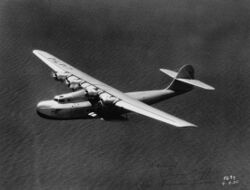Engineering:Hawaii Clipper
 The Martin M-130 was capable of landing on water, making it possible to extend commercial air flight to locations without runways. | |
| Accident | |
|---|---|
| Date | July 28, 1938 |
| Summary | Disappearance |
| Site | western Pacific Ocean Last sighted at [ ⚑ ] 12°16′12″N 130°24′0″E / 12.27°N 130.4°E |
| Aircraft | |
| Aircraft type | Martin M-130 |
| Operator | Pan American Airways |
| Registration | NC14714 |
| Flight origin | San Francisco |
| Stopover | Guam |
| Destination | Manila |
| Passengers | 6 |
| Crew | 9 |
| Fatalities | 15 |
| Injuries | 0 |
| Survivors | 0 |
Hawaii Clipper was one of three Pan American Airways Martin M-130 flying boats. It disappeared with six passengers and nine crew en route from Guam to Manila, on July 28, 1938.
Trans-Pacific service
Pan American initiated trans-Pacific airmail service on 22 November 1935, and began carrying passengers in October 1936. The flying boat service between San Francisco Bay and Manila Bay required about 60 hours of flying time over six days, with intermediate stops at Pearl Harbor, Midway Atoll, Wake Island, and Guam.[1] The flight, Trip 229, first took off from Alameda, California.[2]
Disappearance
Hawaii Clipper departed Guam on the last leg of the westbound journey at 11:39 local time on 28 July 1938. The last radio contact was 3 hours 27 minutes later, when the aircraft reported flying through layers of clouds and moderately rough air 565 miles (909 km) from the Philippine coast.[3]
The US Army transport ship USAT Meigs found an oil slick along the course of the lost aircraft about 500 miles (800 km) from Manila, took samples, and stood by to investigate.[3] Search for the plane was called off on August 5, 1938.[4] Later tests on the oil samples collected by Meigs indicated no connection with the aircraft.[5] Modern reviews of the events and oil sampling techniques have led some to conclude the test of oil from the tropical Pacific compared to samples from San Francisco were not conclusive in ruling out a link with a slick found close to the last estimated position allowing for ocean currents.[6]
Hawaii Clipper was the first of the initial three long-range flying boats to be lost. It was the worst Pacific airline accident at the time, although fatalities were higher when the other two Martin M-130 flying boats crashed later. The Philippine Clipper crash of 1943 killed 19, and 23 were killed when China Clipper crashed in 1945.[7]
See also
- Malaysia Airlines Flight 370
References
- ↑ Klaás, MD (December 1989). "Clipper Across the Pacific, Part One". Air Classics 25 (12): 20.
- ↑ Report, p. 4.
- ↑ 3.0 3.1 AP News (30 July 1938). "Telltale Surface on Ocean Found by Transport Meigs". The Sun (wordpress.com). http://lostclipper.files.wordpress.com/2011/08/clipper-20.pdf. Retrieved 28 December 2011.
- ↑ "Aviation Safety Network". 10 October 2006. http://aviation-safety.net/database/record.php?id=19380728-0&lang=en. Retrieved 3 October 2010.
- ↑ "The CAA Investigation". lostclipper. 20 August 2011. http://lostclipper.com/the-investigation/. Retrieved 28 December 2011.
- ↑ Myhre, Jon F (16 February 2013). "The Hawaii Clipper – A Revised Estimate". Archived from the original on 20 October 2014. https://web.archive.org/web/20141020051918/http://www.discoveryofflight19.com/uploads/8/1/4/4/8144830/hawaiiclipperestimate_2-16-13.pdf. Retrieved 3 July 2014.
- ↑ Aviation Safety Network October 23, 2006, URL retrieved on 9 June 2011
External links
- Air Safety Board of the Civil Aeronautics Authority
 |

